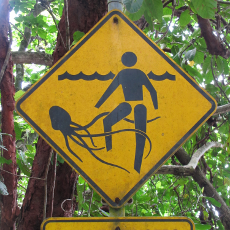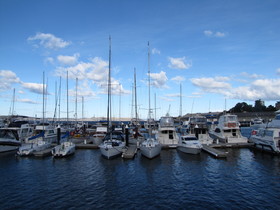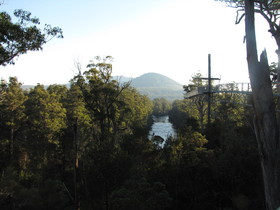I recently went on a driving/camping trip into Carnarvon Gorge, which is about a 720 km (450 miles) drive to the north-west of Brisbane. (Well, I actually did this a little over a month ago now but I never got around to organising photos until now…)
The drive to Carnarvon Gorge was a long one… I was sole driver due to a lack of drivers license being held by the other person coming on the trip. It also rained fairly heavily most of the way and the roads were in a bit of disrepair. Luckily the traffic was low so you could just drive on the other side of the road to avoid the larger potholes. The heavy rain did make it less likely that a kangaroo would jump in front of me, so that was a bonus I suppose. However, it made the actual road into the Gorge into mud (it is gravel and had just been graded) with multiple flooded sections. Fortunately, none of the flooding was too deep to ford, so we slid our way to the camping ground.
 My main motivation for driving that far was to see an Emu (pictured) because I have never seen any of the Ratites (large flightless birds) in the wild before. The region also provided a good chance of seeing both Australian Mudnesters (White-winged Chough and Apostlebird) and the Australian Bustard, all of which I had not seen before. Seeing all these was completed by the time we put up our tents on the first night, so that was a real bonus after the hard drive.
My main motivation for driving that far was to see an Emu (pictured) because I have never seen any of the Ratites (large flightless birds) in the wild before. The region also provided a good chance of seeing both Australian Mudnesters (White-winged Chough and Apostlebird) and the Australian Bustard, all of which I had not seen before. Seeing all these was completed by the time we put up our tents on the first night, so that was a real bonus after the hard drive.
During the first night, the wind really picked up. Trees fell down in the camping area and blocked the road out for the start of the morning… Not that I was affected by that, because the creek at the entrance to the camping grounds has also substantially risen and I could not cross it with the car for a few hours anyway. We were actually quite lucky to take no damage to car or tents (and the people inside) looking at the size of a branch that fell only 20 metres away from where we camped.
 When we finally escaped the camping ground, it was on to the main point of the trip; the main Gorge walking track with all its side-tracks to various attractions. The main track follows the river winding between spectacular sandstone cliffs. But as we were to find out, that track involves many river crossings. These are normally nice step-across-the-boulder affairs, but the rain meant that the river had risen quite substantially and the track was officially closed for the day. Luckily, that was more to keep groups of elderly from crossing the river and the ranger indicated he would let us cross some time in the early afternoon. A couple of short walks of little note and a decent lunch and we were on our way.
When we finally escaped the camping ground, it was on to the main point of the trip; the main Gorge walking track with all its side-tracks to various attractions. The main track follows the river winding between spectacular sandstone cliffs. But as we were to find out, that track involves many river crossings. These are normally nice step-across-the-boulder affairs, but the rain meant that the river had risen quite substantially and the track was officially closed for the day. Luckily, that was more to keep groups of elderly from crossing the river and the ranger indicated he would let us cross some time in the early afternoon. A couple of short walks of little note and a decent lunch and we were on our way.
 The flooding did make the river crossings far more time consuming than expected (some were mid-thigh level…) and did I mention that there were many of them, so we had to skip most of the side-attractions on the walk to the Big Bend camping area for that night in order to get there before dark. The only attraction we made it to on the first day was the Amphitheatre. The Amphitheatre is a gouged out hold in the sandstone that is about 60m tall on all sides. The entrance is a crack in one of the walls. And it lives up to its name, reflecting all sounds made such that you could whisper to a person on the other side and they would hear you clearly.
The flooding did make the river crossings far more time consuming than expected (some were mid-thigh level…) and did I mention that there were many of them, so we had to skip most of the side-attractions on the walk to the Big Bend camping area for that night in order to get there before dark. The only attraction we made it to on the first day was the Amphitheatre. The Amphitheatre is a gouged out hold in the sandstone that is about 60m tall on all sides. The entrance is a crack in one of the walls. And it lives up to its name, reflecting all sounds made such that you could whisper to a person on the other side and they would hear you clearly.
We had intended to camp for two nights at the Big Bend camping area, and leave in somewhat of a hurry on the final day, but we decided to skip the planned walk to a lookout at the top of the sandstone cliffs and instead take a slower walk out and stop at all the side attractions we missed on the first day. This actually turned out to be a good plan as we were unable to locate the entrance to the walk to the top of the cliffs anyway. Well, it turns out that maybe we did locate it, but we dismissed it as a crack in the side of the cliff because of the amount of debris that had been washed into it.
There are two main areas of Aboriginal art works to see on the side tracks; Cathedral Cave and The Art Gallery. Apparently the Art Gallery is one of the best examples of stencil art in Australia and it did live up to its billing with outlines of boomerangs, shields, axes and some weird double handed arms.
The final attraction on the way out was the Moss Garden. We attempted to get to this on the first day but the river was too flooded then. Luckily it had lowered enough for us to get into on the return walk. The Moss Garden is a cut path in the sandstone that receive little sunlight so has sheets of moss over all its walls. This is quite a difference from the rather dry landscape all around it and was very peaceful with the crystal clear creak in a small waterfall in the middle.
And from there, it was a straight walk back out to the car. In total we made forty-two river crossings over the two days of walking (did I mentioned there were many river crossings already?). We stayed overnight in our original camping spot and managed a to drive home at a nice relaxed pace the next day in quite reasonable weather, only breaking heavily to avoid one kangaroo.




 My main motivation for driving that far was to see an
My main motivation for driving that far was to see an 


